The Solar Magnetic Activity Research Telescope
(SMART)
|
The recent development of human space activity requires
accurate space weather forecasting through the study of
solar explosive phenomena and their origins. Such phenomena
can endanger life due to the effects of high energy particles
and radiation. The Solar Magnetic
Activity Research Telescope (SMART) which was built in 2003, is
a state-of-the-art instrument that combines high resolution H alpha
full disk observations and vector magnetic field measurements. This
allows us to investigate the development of magnetic activity and the
mechanisms responsible for energy storage and release in the solar atmosphere.
|
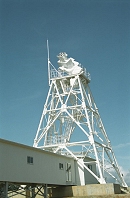
A snap shot of the SMART
|
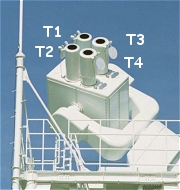
The telescopes of the SMART
|
SMART consists of four different telescopes with apertures of 20 or 25 cm. They are placed on a tower with a height of 16m.
|
- T1: For H-alpha full disk observations
-
This telescope acquires solar H alpha full disk images at high
spatial and temporal resolution thus enabling us to monitor any
explosive events that take place at any position on the sun.
[SMART H-alpha data archive]
- T2: For vector magnetic field measurements
-
Information about the three dimensional photospheric (vector) magnetic
field can be obtained with this telescope. Vector magnetic field
measurements are essential for understanding solar explosive events.
[Sample images of the magnetograph]
- T3: For H-alpha/continuum high speed observations
-
Partial images with high spatial and temporal resolutions are
useful to study the dynamic evolution of structures and
the energy release mechanism of solar flares.
[Quick look (calendar)]
- T4: Multipurpose telescope
-
This telescope is designed for obtaining partial H alpha images and
measurements of the vector magnetic field. In magnetogram mode it can acquire
partial frame images of the photospheric magnetic field with higher
spatial resolution and quality than those of T2.
|
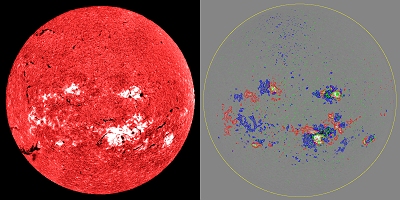
This figure shows a solar full disk image taken on 30th October,
2003. Left panel : H alpha
image (using T1). Right
panel : Vector magnetogram. The green lines demonstrate the
directions of the magnetic field lines, and the red and blue contours
correspond to positive and negative magnetic polarities,
respectively.
|
You can see and download H-alpha full solar-disk images
that were observed after July 2005 with T1 and
partial region images that were obtained from June 2007 to August 2008 with T3.
[Go to the SMART H-alpha Data Archives Page]
|
|
Papers using SMART data
|
|
"Features of Solar Telescopes at the Hida Observatory and the Possibilities of Coordinated Observations with SolarB"
|
UeNo, S. et al.
ASP Conference Series, 325, 319, 2004
|
|
"The development of filter vector magnetographs for the Solar Magnetic Activity Research Telescope (SMART)"
|
UeNo, S. et al.
SPIE, 5492, 958, 2004
|
|
"Triggering Mechanism for the Filament Eruption on 2005 September 13 in NOAA Active Region 10808"
|
Nagashima, K. et al.
The Astrophysical Journal, 668, 533-545, 2007
|
|
"Three Successive and Interacting Shock Waves Generated by a Solar Flare"
|
Narukage, N. et al.
The Astrophysical Journal, 684, L45-L49, 2008
|
|
"Evolution of Anemone AR NOAA 10798 and the Related Geo-Effective Flares and CMEs"
|
Asai, A. et al.
Journal of Geophysical Research, 114, A12, A00A21, 2009
|
|
"First Simultaneous Observation of an H-alpha Moreton Wave, EUV Wave, and Filament/Prominence Oscillations"
|
Asai, A. et al.
The Astrophysical Journal, 745, L18, 2012
|
|
"High-Speed Imaging System for Solar-Flare Research at Hida Observatory"
|
Ishii, T.T. et al.
Publ. Astron. Soc. Japan 65, 39, 2013
|
|
"The Tandem Etalon Magnetograph of the Solar Magnetic Activity Research Telescope (SMART) at Hida Observatory"
|
Nagata, S. et al.
Publ. Astron. Soc. Japan 66, 45, 2014
|
|
"Temporal Evolution and Spatial Distribution of White-light Flare Kernels in a Solar Flare"
|
Kawate, T. et al.
The Astrophysical Journal, 833, 50, 2016
|
|
"A New Solar Imaging System for Observing High-Speed Eruptions: Solar Dynamics Doppler Imager (SDDI)"
|
Ichimoto, K. et al.
Solar Physics, 292, 63, 2017
|
|
"Increase in the Amplitude of Line-of-sight Velocities of the Small-scale Motions in a Solar Filament before Eruption"
|
Seki, D. et al.
The Astrophysical Journal, 843, L24, 2017
|
T1: For H-alpha full disk observation
*About Solar Dynamics Doppler Imager (SDDI)
*The following table shows original specifications before the SDDI
| Objective lens |
Effective apature | 200 mm |
| Working apature | 200 mm |
| Number of lens | 3 |
| Imaging |
Field of view(FOV) | 2300 arcsec |
| Reliable FOV for wavelength-shift (diameter) | 2000 arcsec |
| Effective FOV | 2300 arcsec |
| Central wavelength | 6562.81 |
| Filter |
Type | Lyot |
| Apature | 40.0 mm |
| Total length of the elements | 191.8 mm |
| FWHM | 0.25 A |
| CCD | Size | 36 mm |
| Pixel Number | 4000 x 4000 |
| Max. Time Resolution | 4 sec |
| Optics |
Total focal length | 3228.63 |
| Total F ratio | 16.14 |
| Path of light (click!) |  |
T2: For vector magnetic field measurement
| | Full disk | Partial frame |
| Objective lens |
Effective apature | 200 mm | 200 mm |
| Working apature | 100 mm | 200 mm |
| Number of lens | 3 | 3 |
| Imaging |
FOV | 2000 arcsec | 500 arcsec |
| Reliable FOV for wavelength-shift (diameter) | 1951 arcsec | 707.11 arcsec |
| Effective FOV | 2000 arcsec | 707.11 arcsec |
| Central wavelength | 6302.50 A | 6302.50 A |
| Filter |
Type | Lyot |
| Apature | 30.0 mm |
| Total length of the elements | 272.1 mm |
| FWHM | 0.125 A |
| CCD |
Size | 28 mm | 28 mm |
| Pixel Number | 2000 x 2000 | 2000 x 2000 |
| Max. Time Resolution | | |
| Optics |
Total focal length | 2886.91 mm | 11547.60 mm |
| Total F ratio | 28.87 | 57.74 |
| Path of light |  |  |
T3: For H-alpha/continuum high speed observations
previous version
| Objective lens |
Effective apature | 250 mm |
| Working apature | 250 mm |
| Number of lens | 3 |
| Filter |
H-alpha | Andover 656.3nm (3A) |
| Continuum | Andover 647nm (10A) |
| CCD |
size | 7.4 um |
| Pixel Number | 1600 x 1200 (pixel)^2 |
| Field of View | 344 x 258 (arcsec)^2 |
| Max. Time Resolution | 0.03 sec (30frames/sec) |
| Optics |
Total focal length | 7425.6 mm |
| Total F ratio | 29.70 |
| Path of light (click!) | 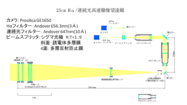 |
| 3D CAD (click!) | 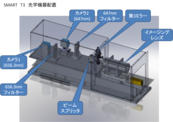 |
T4: Multipurpose telescope (Polarization measurement)
previous version
| Objective lens |
Effecitve apature | 250 mm |
| Working apature | 250 mm |
| Number of lens | 4 |
| Filters |
Type | Fabry-Perrot (Tandem) |
| Apature | 60.0 mm |
| Wavelength | 630.25 nm |
| FWHM | 0.16 A |
| CCD |
size | 7.4 um |
| Pixel Number | 1600 x 1200 (pixel)^2 |
| Field of View | 450 x 340 (arcsec)^2 |
| Max. Time Resolution | 0.03 sec (30frames/sec) |
| Optics |
Total focal length | 24751.8 mm |
| Total F ratio | 99.01 |
| Path of light (click!) | 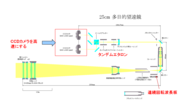 |
| 3D CAD (click!) |  |
|



